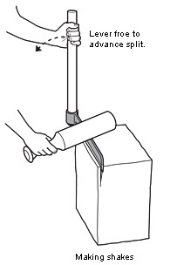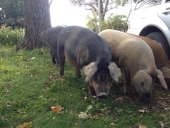
 2
2






 3
3




 7
7




"People get out your way, when you're on fire". Richard Prior
 6
6




![Filename: LOG_CULTURE-hand_drillin_holes-_FungiAcademy.com.jpg
Description: log inoculation techique: hand drilling holes for spawn, FungiAcademy.com.jpg [Thumbnail for LOG_CULTURE-hand_drillin_holes-_FungiAcademy.com.jpg]](/t/95667/a/67312/LOG_CULTURE-hand_drillin_holes-_FungiAcademy.com.jpg)






 3
3






 3
3




Chris Holcombe wrote:Here’s a view of the logs...
 1
1














Brian Rodgers wrote:Neato. You didn't mention the diameter of the remaining logs. Those of us not in the Pacific Northwest might be wondering if they have a value added worth as lumber. Would you be able to show some images of your recent resource so we might better imagine what could be made from it? There is a small company here in New Mexico for example that makes end grain flooring from small diameter trees.
Old Wood Flooring
Brian


 2
2




SKIP books, get 'em while they're hot!!! Skills to Inherit Property

 2
2




Argue for your limitations and they are yours forever.
 3
3




Chris Holcombe wrote:I I’m wondering what uses we can come up with to sequester that carbon instead of the usual cut for firewood.
"The rule of no realm is mine. But all worthy things that are in peril as the world now stands, these are my care. And for my part, I shall not wholly fail in my task if anything that passes through this night can still grow fairer or bear fruit and flower again in days to come. For I too am a steward. Did you not know?" Gandolf
 2
2




Chris Holcombe wrote:
Brian Rodgers wrote:Neato. You didn't mention the diameter of the remaining logs. Those of us not in the Pacific Northwest might be wondering if they have a value added worth as lumber. Would you be able to show some images of your recent resource so we might better imagine what could be made from it? There is a small company here in New Mexico for example that makes end grain flooring from small diameter trees.
Old Wood Flooring
Brian
That end grain flooring is certainly interesting looking! I would've never thought of that. :) I'd say the diameter of some of the logs is 3ft or more.
"People get out your way, when you're on fire". Richard Prior
 4
4






 1
1




Marco Banks wrote:
Chris Holcombe wrote:I I’m wondering what uses we can come up with to sequester that carbon instead of the usual cut for firewood.
If the goal is to sequester that carbon for a couple of thousand years, make biochar. That much wood would make a LOT of biochar.
It would also make a lot of mushrooms, but that doesn't sequester the carbon. Every bit of it would eventually gas-off and return to the atmosphere. But, you know, yummy yummy mushrooms.
- Peter McCoy, Radical Mycology, p.38...fungi are central to the global carbon cycle. Of the 15 billion metric tons (Gt) of total fungal biomas estimated on Earth, about 5 Gt is made of carbon. Much of this tissue is found in soils, where it acts as a carbon reserve, or "sink," for the environment and as a food source for innumerable microbes. Indeed, soils store more carbon that plant vegetation. Much of this is released from wood, which only fungi are capable of decomposing.
-Paul Stamets, Biohabitats.comThere are waves of mycelium running through ecosystems that are beyond our sight. About 30% of healthy soil is composed of organisms, living and dead. The majority (70%) of those organisms by biomass are fungi.
 1
1




Chris Holcombe wrote:I've tried mushrooms a few times in the past and I can never seem to get them to fruit for some reason. I'm not sure what I'm doing wrong. Maybe the summer here is just too dry?

 1
1




Standing on the shoulders of giants. Giants with dirt under their nails
 2
2




Some places need to be wild
 1
1







|
Poop goes in a willow feeder. Wipe with this tiny ad:
Back the BEL - Invest in the Permaculture Bootcamp
https://permies.com/w/bel-fundraiser
|





